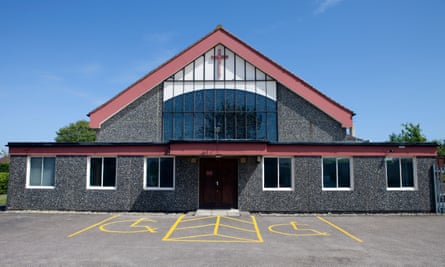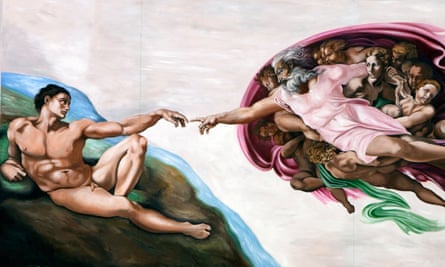The Sistine Chapel is easy to find. Just follow the A259 through Goring-by-Sea until you see the low, spireless red brick English Martyrs Church. Enter this Catholic place of worship – and look up.Above the simple wooden pews, laid out in bold yellows, greens, pinks and blues, you can see God dividing the land and waters, making the sun and Earth, reaching out a powerful finger to spark life into Adam.
It’s Michelangelo’s masterpiece all right, superbly replicated by the Sussex church’s deacon, Gary Bevans. Created between 1987 and 1993, his achievement seems all the more remarkable now that digital reproductions of the original are having a bit of a moment. HBO’s The Young Pope and its follow-up The New Pope both use hi-tech digital copies, as does Netflix’s The Two Popes. Yet Bevans’ version is hand-painted. That makes it a human story – and a human masterpiece.
“I’m a trained signwriter,” says Bevans as we gaze up at the prophets, nudes and scenes from Genesis. “That was my craft when I left school. It’s a lovely old craft – pub signs, shop fronts, lorries before they were done in vinyl. I had a love of doing old masters for pleasure.”

Bevans never went to art college: everything he knows about fine art he has “picked up by experience” and by curiosity. “I like the Renaissance: I see that as the height of western art. I do love to see the visual in a church – smells and bells. It lifts you from the bland reality of life. All churches should be like this.”
Certainly, if you like incense and tolling bells, there’s no place like Rome. Michelangelo gave the Vatican its defining glory when, in 1508, he started to fresco the vaulted ceiling of the papal chapel built by Pope Sixtus IV (hence “Sistine”). When Bevans saw the ceiling for himself in the 1980s, it was midway through a restoration that had uncovered a much more luminous and colourful creation than anyone expected.
“About 20 of us went from here to Rome on a pilgrimage,” says Bevans. “I came back and looked at this white ceiling and thought, ‘Wouldn’t it be nice to have Renaissance art here.’”
The parish priest was cautiously encouraging, saying: “‘Do you think you could do it?’” As progress was made, TV cameras and tourists were drawn in, their contributions helping to fund the work. Bevans himself wasn’t paid and had to keep one eye on his sign-painting business. “Juggling my time, I had to make sure I provided for my young children and wife.”

As a signwriter, he was used to filling precisely planned spaces to the millimetre. When he started his epic task, he had to map out the whole 100ft painting on a grid. Then he built a wooden vaulted surface under the church roof, primed it in white, and copied his drawing onto it.
The result is perfect. Sussex’s Sistine is two-thirds the size of the original, and its proportions are bang on, making it a mathematical as well as an artistic feat. In the Renaissance, this command of large-scale perspective was called quadratura. While you won’t find many modern art schools teaching the technique, Bevans’s grasp of it perfectly captured the spatial intricacy of Michelangelo’s original.
Bevans also came to know the agony and ecstasy that Michelangelo experienced. Like the old master, Bevin stood on a platform to paint, with his head bent up – he did not lie on his back as is sometimes believed. “At first I could only do it for 20 minutes. It took me six months to be able to paint like that for four to six hours at a time.” He almost fell off the scaffold, too.

One difference is that, because Bevans was painting on wood rather than plaster, he couldn’t use the classic fresco technique, having to opt instead for acrylics. But he caught Michelangelo’s mood. In the 1500s, Raphael, who was painting other Vatican rooms nearby, caricatured Michelangelo as a brooding, anti-social misery. Bevans also became preoccupied and introspective, putting up screens to conceal him from curious visitors and refusing a request from Time magazine to photograph his work.
“I became a sort of recluse – this solitary figure who would appear at about eight at night and paint through till morning. Of course, I didn’t have candles on my head, I had proper lights. The scaffold became my sanctuary. I only had to run the gauntlet when I came down to the loo.”
He was, he says, taking a “spiritual journey”. After all, how could a signwriter with no advanced painting training hope to imitate one of the greatest artists ever? “It increased and deepened my faith because I knew I couldn’t do it on my own. Every night I would kneel and pray. Every bit is done for the glory of God.”

Comments (…)
Sign in or create your Guardian account to join the discussion